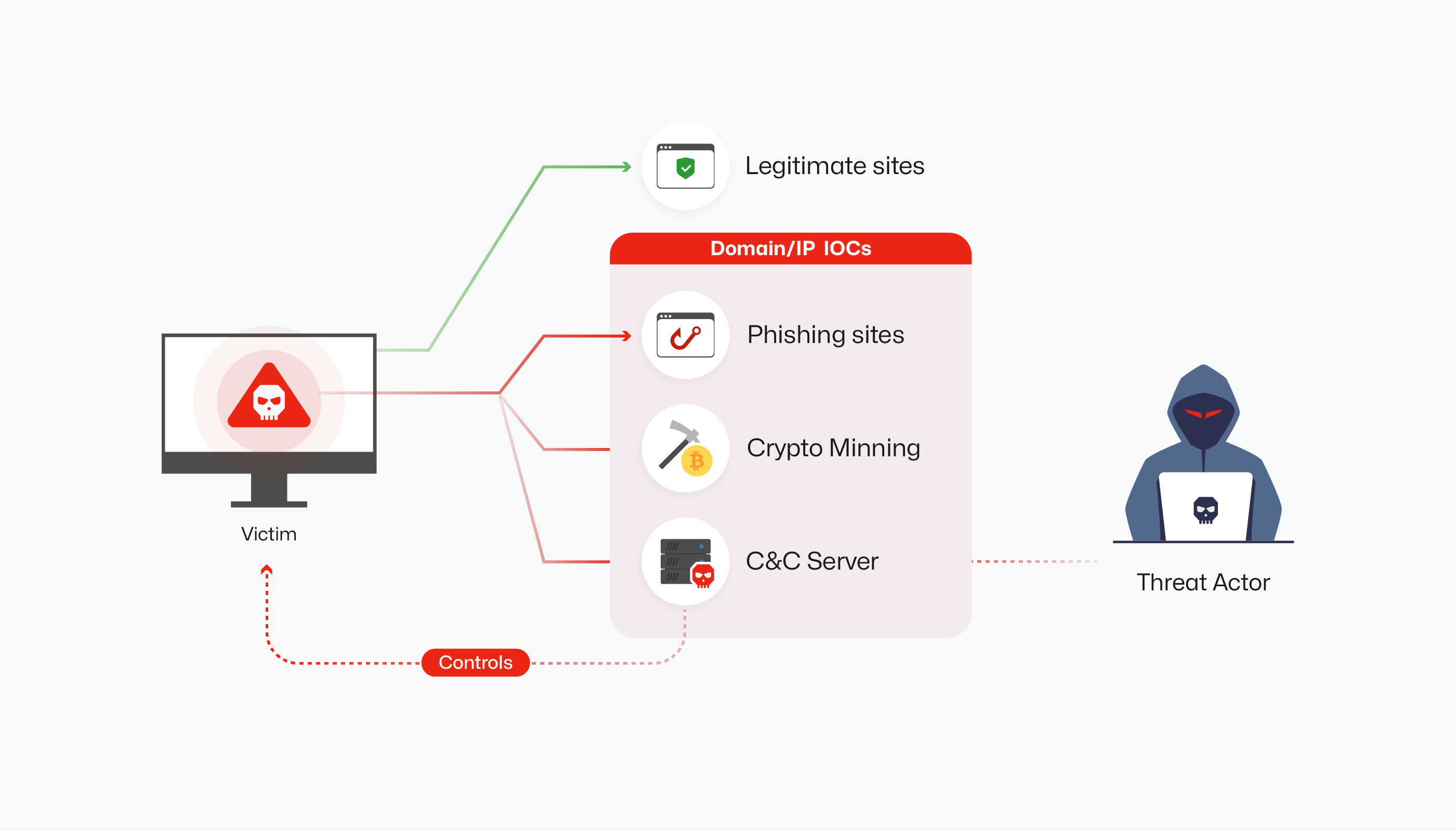Skip to main contentWhat is Compromise Detection?
Compromise in cybersecurity signifies a situation where the security of a system or network has been breached. This can involve unauthorized access, data loss, modification, or policy violation. Early detection is crucial to minimize damage and attacker dwell time. Monitoring for Indicators of Compromise (IOCs) helps identify past attacks and improve future security. A strong security strategy combines reactive and proactive measures.
The Significance of Domain Names and IP Addresses as IOCs
 Network-based IOCs like domain names and IP addresses are vital for detecting compromises because attackers, regardless of the initial intrusion method, often rely on network connections for command and control (C2), data exfiltration, or phishing campaigns. Malicious domains and IPs serve as communication channels. Monitoring outbound network traffic for connections to unfamiliar or suspicious destinations can help identify such activity; blocking access to these destinations is crucial for preventing further impact. Sharing these IOCs as threat intelligence helps others proactively defend against the same attackers.
Network-based IOCs like domain names and IP addresses are vital for detecting compromises because attackers, regardless of the initial intrusion method, often rely on network connections for command and control (C2), data exfiltration, or phishing campaigns. Malicious domains and IPs serve as communication channels. Monitoring outbound network traffic for connections to unfamiliar or suspicious destinations can help identify such activity; blocking access to these destinations is crucial for preventing further impact. Sharing these IOCs as threat intelligence helps others proactively defend against the same attackers.
Leveraging SecAI IOC Datasets for Compromise Detection within Your Organization
Enhance your organization’s compromise detection with SecAI’s IOC datasets, boasting 99.99% accuracy. SecAI delivers a comprehensive and highly reliable collection of Indicators of Compromise, including C&C domains and IP addresses, associated malware families, related threat actors and campaigns, attribution to APTs where available, and malware hash values. Updated on a minute-by-minute basis, this accurate, real-time, rich, and precise contextual information empowers more effective identification of security breaches and informed incident response.
Use SecAI Investigator to directly query specific domains or IP addresses and identify IOCs. This allows for quick checks or targeted investigations and a deeper understanding of potential threats relevant to your organization.
Furthermore, to seamlessly integrate this timely data into your existing security infrastructure, SecAI’s IOC data can be ingested via SaaS API or data feeds(both coming soon). This involves feeding SecAI’s IOC data into your security tools, such as Security Information and Event Management (SIEM) systems and Threat Intelligence Platforms (TIPs). SIEM systems can correlate SecAI’s IOCs with your network traffic, system logs, and other relevant data for enhanced and up-to-the-minute analysis. TIPs can centralize, enrich, and disseminate SecAI’s threat intelligence to various security controls within your organization, enabling proactive blocking and detection capabilities with the latest threat intelligence delivered through your preferred integration method.  Network-based IOCs like domain names and IP addresses are vital for detecting compromises because attackers, regardless of the initial intrusion method, often rely on network connections for command and control (C2), data exfiltration, or phishing campaigns. Malicious domains and IPs serve as communication channels. Monitoring outbound network traffic for connections to unfamiliar or suspicious destinations can help identify such activity; blocking access to these destinations is crucial for preventing further impact. Sharing these IOCs as threat intelligence helps others proactively defend against the same attackers.
Network-based IOCs like domain names and IP addresses are vital for detecting compromises because attackers, regardless of the initial intrusion method, often rely on network connections for command and control (C2), data exfiltration, or phishing campaigns. Malicious domains and IPs serve as communication channels. Monitoring outbound network traffic for connections to unfamiliar or suspicious destinations can help identify such activity; blocking access to these destinations is crucial for preventing further impact. Sharing these IOCs as threat intelligence helps others proactively defend against the same attackers.

